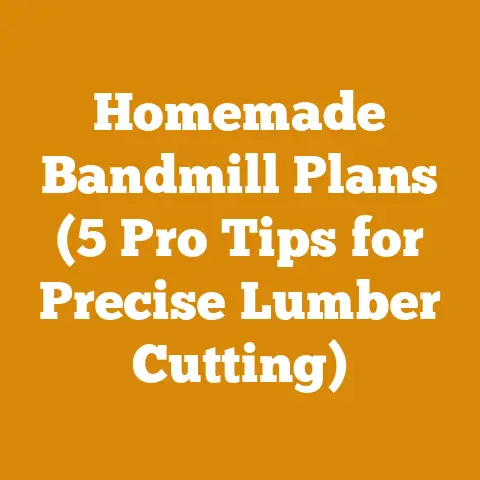Are Eddie Bauer Boots Good for Firewood Cutting? (5 Pro Tips)
Let’s bust a myth right off the bat: you can wear any old boot when you’re out there wrestling with logs and a chainsaw. Nope. That’s a recipe for disaster. I’ve seen it happen too many times – a twisted ankle, a nasty cut, or worse. And that brings us to the burning question: Are Eddie Bauer boots good for firewood cutting? That’s what we’re going to delve into, with five pro tips to help you make the right decision.
The Global Firewood Frenzy: Why Footwear Matters More Than Ever
Before we dive deep into Eddie Bauer boots, let’s set the stage. The demand for firewood is surging globally. Whether it’s for supplemental heating, outdoor cooking, or the simple ambiance of a crackling fire, more and more people are turning to wood. According to a recent report by the FAO (Food and Agriculture Organization of the United Nations), fuelwood remains the primary source of energy for cooking and heating for nearly a third of the world’s population. In North America and Europe, the resurgence of wood-burning stoves and fireplaces, coupled with rising energy costs, has fueled a mini-boom in the firewood industry.
This boom, however, comes with its own set of challenges. More people are cutting their own firewood, often without the proper training or equipment. Safety is paramount, and that starts from the ground up – literally.
Eddie Bauer Boots and Firewood Cutting: The Initial Assessment
Eddie Bauer is a well-known brand, synonymous with outdoor apparel and footwear. They offer a wide range of boots, from hiking boots to work boots. But are they specifically designed for the rigors of firewood cutting? That’s where we need to get discerning.
The key characteristics I look for in firewood cutting boots are:
- Ankle Support: Crucial for preventing twists and sprains on uneven terrain.
- Steel Toe Protection: A non-negotiable for safeguarding your toes from falling logs or a misplaced axe.
- Cut Resistance: Protection against chainsaw mishaps. Some boots even feature ballistic nylon or cut-resistant fabrics.
- Water Resistance: Keeping your feet dry in wet conditions is essential for comfort and preventing blisters.
- Good Traction: Preventing slips on muddy or icy surfaces.
- Durability: Withstanding the wear and tear of heavy use.
Now, let’s see how Eddie Bauer boots typically stack up against these criteria. Generally, Eddie Bauer boots are known for their comfort and durability. Many models offer good ankle support and water resistance. However, not all models feature steel toes or cut-resistant materials.
This is where the “pro tips” come into play. You can’t just grab any Eddie Bauer boot and expect it to be suitable for firewood cutting. You need to be selective.
5 Pro Tips for Choosing the Right Boots for Firewood Cutting (Eddie Bauer or Otherwise!)
Tip #1: Prioritize Safety Features Above All Else
This might seem obvious, but it’s worth repeating: safety first. When you’re dealing with heavy logs, sharp tools, and potentially unpredictable environments, the right safety features can be the difference between a productive day and a trip to the emergency room.
Steel Toe vs. Composite Toe:
- Steel Toe: Offers the highest level of protection against impact and compression. Steel toe boots are generally heavier and can conduct cold in winter, which can be a drawback.
- Composite Toe: Made from non-metallic materials like plastic, carbon fiber, or Kevlar. They are lighter than steel toe boots and don’t conduct cold. They provide good protection but may not be as strong as steel in extreme impact situations.
My Recommendation: For firewood cutting, I lean towards steel toe boots for the added protection. The weight is a minor inconvenience compared to the potential for a serious injury.
Cut Resistance:
This is a feature often overlooked, but it’s incredibly important. Look for boots that feature cut-resistant materials like ballistic nylon or Kevlar in the upper. These materials can help protect your feet and ankles from accidental chainsaw contact. Some specialized logging boots even have full-wrap cut-resistant liners.
Example: Let’s say you’re bucking a log and your saw kicks back, glancing off your boot. A standard leather boot might be easily cut, but a boot with ballistic nylon reinforcement could prevent a serious injury.
Actionable Step: Check the product description and specifications of any Eddie Bauer boot you’re considering. Look for mentions of steel toe protection and cut-resistant materials. If the information isn’t readily available, contact Eddie Bauer customer service for clarification.
Tip #2: Assess the Terrain and Weather Conditions
The type of terrain you’ll be working on and the weather conditions you’ll be facing will significantly influence your boot selection. Are you working on flat, dry ground, or are you navigating steep, muddy hillsides? Are you cutting firewood in the summer heat or the winter snow?
Terrain Considerations:
- Flat Terrain: Boots with good ankle support and traction are still important, but you might not need the most aggressive lug pattern.
- Uneven Terrain: Look for boots with a high degree of ankle support and a rugged lug pattern for maximum stability.
- Steep Slopes: Boots with a pronounced heel and aggressive lug pattern are essential for preventing slips and falls.
Weather Considerations:
- Dry Conditions: Breathable boots are important for preventing your feet from overheating.
- Wet Conditions: Waterproof boots are a must. Look for boots with a waterproof membrane like Gore-Tex or a similar material.
- Cold Conditions: Insulated boots are essential for keeping your feet warm and preventing frostbite.
My Story: I once spent an entire day cutting firewood in the pouring rain with a pair of boots that were supposedly “water-resistant.” By the end of the day, my feet were soaked, cold, and blistered. It was a miserable experience, and it taught me the importance of investing in truly waterproof boots.
Data Point: Studies have shown that working in cold, wet conditions can significantly decrease productivity and increase the risk of accidents. Keeping your feet warm and dry is not just about comfort; it’s about safety and efficiency.
Actionable Step: Before you buy any boots, take a moment to assess the typical terrain and weather conditions you’ll be working in. This will help you narrow down your options and choose the boots that are best suited for your needs.
Tip #3: Consider the Boot’s Construction and Materials
The construction and materials of a boot will determine its durability, comfort, and overall performance.
Leather vs. Synthetic:
- Leather Boots: Known for their durability and ability to mold to the shape of your foot over time. Full-grain leather is the most durable type of leather.
- Synthetic Boots: Generally lighter and more water-resistant than leather boots. They also tend to be less expensive.
Sole Construction:
- Welted Construction: A durable construction method where the sole is stitched to the upper. Goodyear welt construction is a common and reliable type of welted construction.
- Cemented Construction: The sole is glued to the upper. This is a less expensive construction method, but it’s not as durable as welted construction.
- Molded Construction: The sole is directly molded to the upper. This construction method is often used in waterproof boots.
Midsole:
The midsole provides cushioning and support. Look for midsoles made from materials like EVA (ethylene-vinyl acetate) or polyurethane.
Outsole:
The outsole provides traction. Look for outsoles made from durable rubber compounds with a lug pattern that is appropriate for the terrain you’ll be working on.
My Insight: I’ve found that leather boots with Goodyear welt construction tend to be the most durable and long-lasting option for firewood cutting. They can be resoled when the outsole wears out, extending their lifespan.
Actionable Step: Examine the construction and materials of any Eddie Bauer boot you’re considering. Look for boots with durable leather uppers, Goodyear welt construction, and a rugged rubber outsole.
Tip #4: Prioritize Fit and Comfort
Even the most durable and feature-rich boots are useless if they don’t fit properly. Ill-fitting boots can cause blisters, foot pain, and even long-term foot problems.
Getting the Right Size:
- Measure Your Feet: Use a Brannock device or have your feet measured at a shoe store.
- Try Boots on With Socks: Wear the type of socks you’ll be wearing when you’re cutting firewood.
- Walk Around in the Boots: Make sure there’s enough room in the toe box and that your heel doesn’t slip.
Break-In Period:
Most leather boots require a break-in period. Wear them for short periods of time at first, gradually increasing the amount of time you wear them. Use a leather conditioner to help soften the leather.
Insoles:
Consider adding aftermarket insoles for added cushioning and support.
Personal Story: I once bought a pair of boots online without trying them on first. They were the right size according to the manufacturer’s chart, but they were too narrow for my feet. I ended up with blisters and foot pain after just a few hours of cutting firewood. I learned my lesson: always try on boots before you buy them!
Data Point: Studies have shown that properly fitted footwear can significantly reduce the risk of foot injuries and improve overall comfort and performance.
Actionable Step: Go to an Eddie Bauer store or a shoe store that carries Eddie Bauer boots and try on several different pairs. Walk around in them, and make sure they fit comfortably. Don’t be afraid to ask for help from a sales associate.
Tip #5: Don’t Be Afraid to Consider Alternatives
While Eddie Bauer boots can be a good option for firewood cutting, they’re not the only option. There are many other brands that specialize in work boots and logging boots that may be a better fit for your needs.
Alternatives to Consider:
- Chippewa: Known for their durable and high-quality work boots and logging boots.
- Red Wing: Another well-known brand that offers a wide range of work boots, including logging boots.
- Thorogood: A popular brand among tradespeople and outdoor workers.
- Danner: Known for their high-quality hiking boots and work boots.
- Stihl: Yes, the chainsaw company also makes logging boots. Stihl logging boots are specifically designed for chainsaw safety.
Case Study: A Firewood Producer’s Boot Choice
I know a small-scale firewood producer in Vermont who swears by his Chippewa logger boots. He says they provide excellent ankle support, steel toe protection, and cut resistance. He’s been using them for years, and they’ve held up incredibly well to the rigors of daily firewood cutting.
Cost Considerations:
Work boots and logging boots can be expensive, but they’re an investment in your safety and comfort. Be prepared to spend a bit more for a high-quality pair of boots that will last for years.
Budgeting Tip: Consider buying your boots during a sale or using a coupon. You can often find good deals on work boots online or at sporting goods stores.
Actionable Step: Research other brands of work boots and logging boots. Read reviews and compare features. Don’t be afraid to try on different brands and models to find the boots that are best suited for your needs.
Additional Considerations for Safe Firewood Cutting
Choosing the right boots is just one piece of the puzzle. Here are some additional safety tips to keep in mind when you’re cutting firewood:
- Wear appropriate safety gear: This includes eye protection, hearing protection, gloves, and chaps.
- Use a chainsaw that is properly maintained and sharpened.
- Be aware of your surroundings.
- Never cut firewood alone.
- Take breaks to avoid fatigue.
- Know your limits.
Troubleshooting Common Boot Problems
Even with the best boots, you might encounter some problems. Here are some common issues and how to address them:
- Blisters: Make sure your boots fit properly and wear moisture-wicking socks. Use blister bandages to protect affected areas.
- Foot Pain: Try using aftermarket insoles for added cushioning and support.
- Water Leakage: Apply a waterproofing treatment to your boots.
- Sole Separation: If the sole is glued to the upper, it may be possible to re-glue it. If the sole is welted, it can be resoled by a professional.
Where to Find Logging Tools and Equipment
Here are some resources to help you find the right tools and equipment for firewood cutting:
- Local Hardware Stores: Many hardware stores carry a selection of logging tools and safety gear.
- Sporting Goods Stores: Some sporting goods stores carry work boots and safety gear.
- Online Retailers: Online retailers like Amazon, Northern Tool, and Forestry Suppliers offer a wide selection of logging tools and equipment.
- Specialty Logging Supply Stores: These stores specialize in logging tools and equipment and can offer expert advice.
Next Steps: Gear Up and Get to Work
So, are Eddie Bauer boots good for firewood cutting? The answer is: it depends. Some Eddie Bauer boots may be suitable, but you need to carefully evaluate the features and construction to ensure they meet your safety needs. Remember to prioritize safety, assess the terrain and weather, consider the boot’s construction, prioritize fit and comfort, and don’t be afraid to explore alternatives.
Now that you’re armed with this knowledge, it’s time to gear up and get to work! Stay safe, be prepared, and enjoy the satisfaction of cutting your own firewood. And remember, the right boots are an investment in your safety and well-being. Choose wisely, and you’ll be able to tackle any firewood cutting project with confidence.






